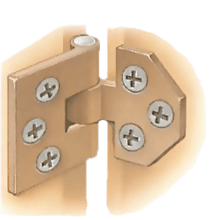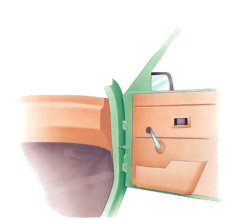Conducteur d'impact

An impact driver has spring pressure to give strong turning power and also shock action when the end is tapped with a hammer. It is therefore very useful for loosening stubborn screws, bolts and nuts, and for extra force when turning. There are interchangeable heads, or bits, of various types and sizes, and it can be fitted with an adaptor for driving sockets.
An impact driver is a manual or power tool that delivers a strong, sudden rotational and downward force. In conjunction with toughened screwdriver bits and socket sets, they are often used by mechanics to loosen larger screws (bolts) and nuts that are corrosively "frozen" or over-torqued. The direction can also be reversed for situations where screws have to be tightened with torque greater than a screwdriver can reasonably provide.
Manual impact drivers consist of a heavy outer sleeve that surrounds an inner core that is splined to it. The spline is curved so that when the user strikes the outer sleeve with a hammer, its downward force works on the spline to produce turning force on the core and any socket or work bit attached to it. The tool translates the heavy rotational inertia of the sleeve to the lighter core to generate large amounts of torque. At the same time, the striking blow from the hammer forces the impact driver down into the screw reducing or eliminating cam out. This attribute is most beneficial for Phillips screws which normally cam out as part of their design. It is also excellent for use with the Robertson square socket head screws that are in common use in Canada. It is less beneficial for slot head screws and is not beneficial at all for most other types.
Powered impact drivers use a motor or compressed air to rapidly and repeatedly deliver rotational and impact forces, providing considerable speed and productivity advantages. They are often used in construction and manufacturing to replace screwdrivers where speed and operator fatigue are significant issues. In some situations however, this type falls short since current designs cannot deliver as much downward blow as a manual unit. This can be especially true on very stubbornly stuck fasteners, or screws (particularly Phillips) with damaged/"stripped" head slots.
These are not to be confused with the impact wrench, which is a tool powered by a motor or compressed air, with a similar name and function. These also use a rotary hammering action to apply torque to fasteners. The difference is that impact wrenches do not provide the downward force and the related additional engagement that impact drivers offer as mentioned above; otherwise the two tools operate in essentially the same fashion mechanically. However, while there is considerable functional overlap, they are not interchangeable; each is particularly well-suited to certain tasks for which the other would be a poor choice.
Read more on Wikipedia
Cet outil est utilisé dans
Doors or bonnet and boot lids that do not close properly may have moved out of alignment and nee...
As well as replacing a door because it has become rusted or been damaged in an accident, you may...


